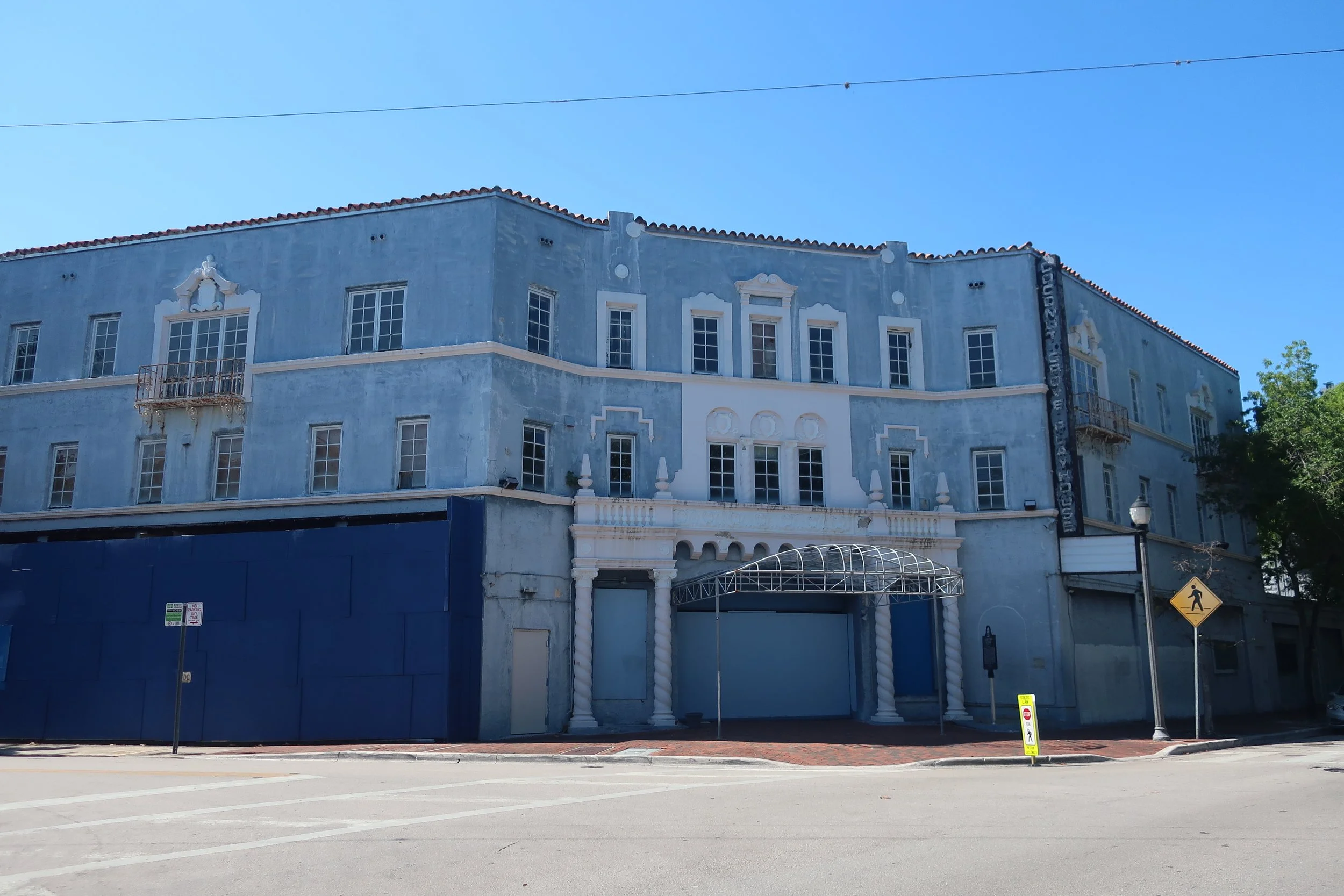Art in Architecture: A Play-less Play House (2021)
The area of Coconut Grove is the oldest continuously populated neighborhood of Miami, as it officially became a part of the city of Miami in 1925. One of Coconut Grove’s most recognizable landmarks happens to be an abandoned building.
The Coconut Grove Playhouse might be one of the most talked-about abandoned buildings in the city. The building first opened its doors in 1927 and has been a staple of the area ever since. Originally a movie theater, the Playhouse has gone through various ups and downs in the past 90-plus years since it was built, as it was abandoned and reopened several times.
According to Debbie Deutch, 58, a longtime resident of the area, the Playhouse used to be a go-to place in the Grove. During its heyday, which was the 1970s and 1980s, it was a popular place, particularly for the local community to attend plays and concerts.
“The Coconut Grove Playhouse used to be a Miami institution. It was an authentic Playhouse that wasn’t Broadway scale. It offered shows, and we always had fun going there. It was and still is a beautiful theater,” Deutch said. “Because of the intimate size, every seat was good, and the prices were reasonable.”
Photo by Adam Spector
One seemingly forgotten fact about the Playhouse was that it had a restaurant.
“When we were young, they had a restaurant right next door that was associated with the Playhouse called Bananas,” Deutch said. “And it was a really fun place to go before a show. It had fun drinks and good food. They were famous for their amazing French toast puffs and they also had homemade potato chips that me and my sisters used to love.”
Although the Coconut Grove Playhouse has been closed for more than a decade, the old-fashioned exterior with its classic 1920s look remains a prominent landmark in the area. This is a rare example of an inactive building that is still significant to the community and adds aesthetic value to the area.
According to Lois Kaufman, a Miami resident for over 60 years, Coconut Grove is one of the few parts of town that does not look radically different from when she first visited. She also mentioned The Coconut Grove Playhouse is the first building that comes to mind when thinking about the Grove.
“It’s an old and now inactive building, but it’s interesting. I just passed it the other day, and it’s an aesthetically nice and unique structure,” Kaufman said. “I usually think about high-rise buildings when I think about landmarks in other cities, and this is certainly different from those. The building certainly has character, even if it is closed off to the public.”
Kaufman had memories of the Playhouse similar to Deutch's.
“It was popular 25-30 years ago, and we did go to it. We enjoyed the atmosphere and it was an interesting place. Once again, it had lots of character,” Kaufman said. “It’s still there. It’s been around since the day I moved to Miami.”
Despite the former popularity of the Playhouse, it had several valid reasons for closing down. Sandy Riley, a historical archivist working for the Woman’s Club of Coconut Grove, has had experience working in the Coconut Grove Playhouse, saying, “A technical director that I worked with for several shows used to talk about how the cement was coming apart and the place was becoming unsafe before its closing.”
Sonia Chao, the Director of the Center for Urban & Community Design at the University of Miami’s School of Architecture, was an event administrator at the Coconut Playhouse before its closing. She explained that in addition to needing a renovation, some of the problems also stemmed back to the original design of the building.
“The theater was at first a movie theater, then it was made into a live theater, and there were even more changes made half a century ago. The leading architect made major changes such as adding more seats and a restaurant,” Chao said. “While the changes helped to have a higher audience capacity, the backstage wasn’t sufficiently large enough. This meant the Playhouse didn’t have the capacities needed to be able to hold performances, that they as a theater, given its size, should in fact offer.”
In other words, the limited size of the backstage made it difficult for the theater to put on productions that met the higher standards of shows put on by other large-scale theaters.
“So they couldn’t get the kind of quality shows that they, in theory, would have the seats to be able to hold because of the size of their staff. For example, they didn’t even have a tall enough space so that they could efficiently change backdrops,” Chao said. “Not only this, but it was still very expensive to put on shows.”
Since its closing in 2006, there have been several attempts to re-open the Playhouse without success.
“Before its closing, we had meetings with many theater and cultural experts that were local, national, and regional. Then we also had open sessions for community members to talk to us about their expectations,” Chao said. “At the time, we did come up with a few different concepts and they had different degrees of mixed uses.”
One idea was to turn the building into a smaller black box theater space that could be more oriented towards community activity. The other idea which gained traction was to keep the front exactly the same and then make the back bigger. Unsurprisingly, this idea was the one that the preservationists preferred the least.
Christine Rupp, the Executive Director at Dade Heritage Trust, explained that there has not been much movement on actual physical rehabilitation because the future is currently tied up in the courts.
“The Playhouse is owned by the state of Florida and the state was looking for someone to come up with a solution. To come up with a plan, Miami Dade County partnered with Florida International University to devise a plan to bring the theater back to back to the Playhouse,” Rupp said. “It was determined by the county that the back part of the Playhouse, where the theater is, could not be rehabilitated. The arguments as to whether or not they should keep the front facade the same and rebuild the rest into a functional theater of its size, or to closely preserve as much of it as possible stalled efforts to renovate the building.”
Despite attempts to make it into a more commercial theater, Sandy Riley mentioned she would like to see the Coconut Grove Playhouse be made into a theater geared towards smaller projects.
“It’s even harder to make it today as a playwright… especially because it’s very difficult to find a theater to try their work,” Riley said. “We're into preservation and that’s sort of our mission… and, because of that, I would, if anything, like to at least see the front facade restored.”
On March 17th, 2020, the board of the county won an appeal that allowed for the demolition of the backside of the Playhouse while preserving the historic front facade. Despite this, little progress has been made as of 2022.
Rupp continued, “The longer they sit, the more they deteriorate, and the more it costs to rehabilitate. And then, at the end of the day, they could just fall into disrepair so much that it ends up being demolished. So we said ‘look, let's go with what the county has to offer.’ We believe they can bring this place back to life for the community, which is ultimately the most important thing.”
While several past efforts to re-open the Coconut Grove Playhouse have stalled, there is still hope that the place will someday be restored.
“It really was a very nice local community event and venue, and it was a big loss for Coconut Grove. It created a lot of traffic for the Grove, and it helped the restaurants in the area. It just made Coconut Grove a more cultural place to be, and I think it’s really sad that it has closed down now, and it’s kind of like an eyesore,” Deutch said. “Where at one point it was a really beautiful old authentic building. We definitely miss having that venue in the area, and I would love to see it back open someday[19] .”
RIP Lois Kaufman (1935-2022)
If You Go (Recommended Nearby Locations)
·The Coconut Grove Playhouse --- 3500 Main Hwy, Miami, FL 33133; For additional information, go to https://www.miamidadearts.org/coconut-grove-playhouse and https://www.playhousefoundation.org
· The Barnacle Historic State Park---3485 Main Hwy, Miami, FL 33133; For questions and additional information, call (305) 442-6866
· Peacock Park---2820 Mcfarlane Rd, Miami, FL 33133; For more information and questions about upcoming events, call (305) 960-4670; Street parking available
· Regatta Park---3400 Pan American Drive; For more information, contact the Parks & Recreation Department of Special Events at (786) 314-6775; Street parking available
Warning:
While trespassing is against the law and is not recommended under any circumstance, it should also be cautioned to potential trespassers that the interior of the Coconut Grove Playhouse contains asbestos.


